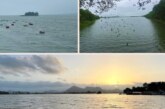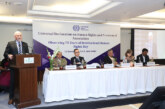
Japan faces soaring number of feared dead
By Laura King, Mark Magnier and Barbara Demick, Los Angeles Times, 13 March 2011
http://www.latimes.com/news/nationworld/world/la-fg-japan-quake-main-20110313,0,7578081,full.story
One police official says the toll could hit 10,000 in his prefecture alone. The reeling nation also contends with a possible meltdown in at least one reactor at the Fukushima No. 1 nuclear plant. Dozens are believed to have been exposed to radiation.
Reporting from Tokyo, Koriyama and Fukushima-The number of missing and feared dead in Japan’s epic earthquake soared Sunday as a reeling nation struggled to contain an unprecedented nuclear crisis, pluck people in tsunami-inundated areas to safety, quell raging blazes and provide aid to hundreds of thousands of frightened people left homeless and dazed.
A police chief in the battered Miyagi prefecture told disaster relief officials that he expected the death toll to rise to 10,000 in his prefecture alone, the Kyodo News Agency said. As the second full post-quake day dawned, authorities said about 400,000 people had been forced to flee the giant swath of destruction — more than half of them evacuees from the area surrounding the Fukushima nuclear complex, 150 miles north of Tokyo. The crisis intensified as officials reported that three of the six reactors at the Fukushima No. 1 plant were in trouble, and that for second day in a row, a building housing one of the reactors could explode.
The country’s chief Cabinet secretary, Yukio Edano, was quoted by a news agency as saying that a meltdown may have occurred in at least one nuclear power reactor and that authorities are concerned about the possibility of a meltdown at a second reactor.
“Even if a blast were to occur in the building containing the [other] reactor, the government doesn’t think the levels of radiation would affect the health of residents who have evacuated the area,” Edano said. “But the fact that we can’t rule out the possibility of a blast is likely to cause some concerns.”
Dozens of people were believed to have been exposed to elevated levels of radiation, but officials sought to reassure the public that there was no significant health risk to the general population, even though cesium and iodine, byproducts of nuclear fission, were detected around the plant. The incident could rank as the worst atomic accident in Japan’s roughly half-century of nuclear power generation.
Bad to worst: A man stares Saturday at what used to be a rice field in Sendai. KYODO PHOTO
“Everybody in my neighborhood is being evacuated,” said Teruko Tsuchiya, 53, who lives four miles from the nuclear plant and was lining-up outside a 7-11 convenience store waiting for food. “The buses are going back and forth. People are scared of course but they are trying to stay calm and it is proceeding in an orderly fashion.”
Tsuchiya said people had enough blankets to get through the frigid nights, but worried many would start going hungry.
 With punishing aftershocks continuing to jolt the quake zone, the Japan Meteorological Agency revised the magnitude of the earthquake to 9.0, Kyodo News agency said. The upgrade made the quake one of the largest ever recorded in terms of magnitude. Adding to the urgency of rescue efforts, the agency said there was a 70% probability of a magnitude-7 quake in the next three days.
With punishing aftershocks continuing to jolt the quake zone, the Japan Meteorological Agency revised the magnitude of the earthquake to 9.0, Kyodo News agency said. The upgrade made the quake one of the largest ever recorded in terms of magnitude. Adding to the urgency of rescue efforts, the agency said there was a 70% probability of a magnitude-7 quake in the next three days.
The Japanese military was mobilizing 100,000 of its personnel, together with ships and planes, for a rescue effort that is a race against time. In a country where every modern convenience has long extended into even remote areas, the basics of daily survival — food, water, power — were unaccustomedly threatened.
Even in Tokyo, where the damage was limited, the rhythms of a normally throbbing metropolis were stilled. In many central districts, the trademark neon blaze was absent on streets that were eerily deserted. The subway system was running again, if sporadically, but on a Saturday evening, when its cars would normally be packed with passengers, some slid through stations all but empty, like ghost trains.
As of early Sunday, the confirmed death toll stood at 963, the Kyodo agency reported, citing police figures. It’s unclear if that included another 200 to 300 unidentified corpses, mostly tsunami victims, that had been transported to Sendai, the hardest-hit big city. “It is believed that more than 1,000 people have lost their lives,” Edano said.
But assessments of the disaster were far from certain. Although the official missing tally stood at 650, in Miyagi prefecture north of Tokyo, officials said Saturday night that there had been no contact with about 10,000 people in the small town of Minamisanriku, more than half its population.
Japan’s peacetime military, the Self-Defense Forces, was mobilizing a relief-and-rescue force of 100,000, the Defense Ministry said, including a special unit to help nuclear evacuees. Nearly 200 aircraft and 45 ships were en route or in the tsunami zone, the ministry said. In one of the unlikeliest rescues, Japanese coast guard reportedly pulled to safety Sunday a 63-year-old man who had been floating on the roof of his home nine miles off the coast of Soma city, in Fukushima.
The U.S. military, whose bases are sometimes an irritant to local Japanese, was also helping in the effort. The Americans said there were no injuries or serious damage at their bases. The USS Ronald Reagan aircraft carrier, was anchored off the coast of Sendai Sunday, said Stephen Valley, a spokesman for U.S. Forces Japan. The nuclear-powered ship is being used as a floating refueling station for Japanese military and coast guard helicopters flying rescue missions in the area and delivering emergency food supplies.
A Ground Self-Defense Force soldier carries an elderly woman whose home was wrecked by the Friday tsunami in Kesennuma, Miyagi Prefecture.
KYODO PHOTO
Despite Japan’s much-vaunted earthquake engineering, which saved countless lives, at least 3,400 buildings were known to have been destroyed by the quake and fires, Kyodo News said, citing the national fire agency. But that figure too could grow exponentially. In the town of Kesennuma, in Miyagi prefecture, fires merged into a mega-blaze stretching for more than half a mile. The welfare ministry said 171 “welfare facilities,” such as nursing homes, had suffered damage.
 Adding to the urgency, nearly 6 million homes were reported to be without electricity, and more than 1 million lacked water. Long lines formed outside stores that were open and selling packaged foods. Many stores limited the amount that each person could purchase. The populace was further traumatized by aftershocks, one of them magnitude 6.7.
Adding to the urgency, nearly 6 million homes were reported to be without electricity, and more than 1 million lacked water. Long lines formed outside stores that were open and selling packaged foods. Many stores limited the amount that each person could purchase. The populace was further traumatized by aftershocks, one of them magnitude 6.7.
The disaster’s economic toll has yet to be fully assessed. Manufacturing heavyweights such as Toyota, Nissan and Honda said production at plants well outside the quake zone were expected to be suspended Monday because of the difficulty in obtaining parts.
At the crippled nuclear complex in Fukushima, authorities were still unable to explain why excess levels of radiation were detected outside the grounds. An explosion was heard near a reactor at the No. 1 plant about 3:30 p.m. Saturday, and plumes of white smoke could be seen. Edano, the Cabinet secretary, said the blast was caused by a buildup of hydrogen in the cooling system, and described the attempt to evacuate about 200,000 people from the area as a precaution.
The International Atomic Energy Agency in Vienna said it was told by Japanese officials that they would distribute iodine tablets to residents near the plant. Iodine is known to protect against thyroid cancer that can develop from radiation poisoning.
The biggest concern about the plant is the possibility of the core overheating and nuclear material escaping from the containment vessel. Japan relies on nuclear power for 30% of its electricity generation.



